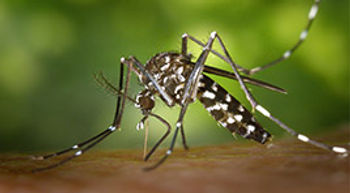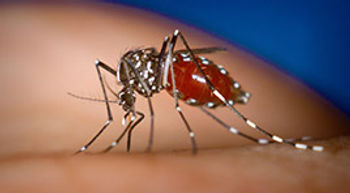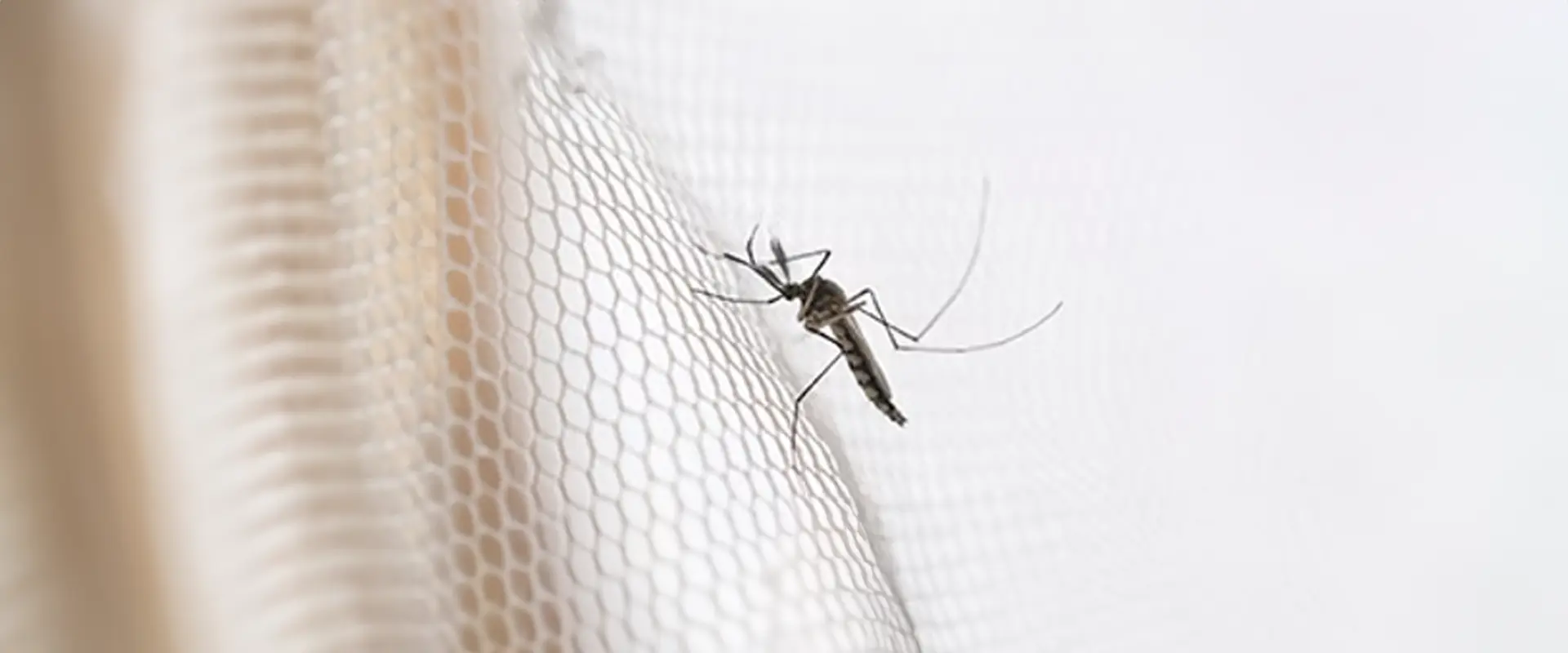Mosquitoes exist across the world, with the exception of Antarctica. More than 3,000 mosquito species have been identified in both the Arctic and subtropics. They are categorized into 39 different genera.

House Mosquito
are approximately 1/8" - 3/4" in length, but can vary in size which is determined by density of larval population, as well as surrounding food supply.
House Mosquitoes generally are a light brown. Some species may also have white bands running across abdomen.
While they are most active just after dusk, being bitten in your own yard usually means that they are breeding somewhere on your property or on a closeby, adjacent property. When there is a lack of food nearby, these mosquitoes will travel up to 14 miles away from their water source to seek feed on blood.
Habitats
House mosquito larvae breed in highly polluted, standing water that remains fairly calm and undisturbed. Larvae may be found along the edges of a pond or a ditch, but they will not be found in a quick-running stream or creek. As a rule of thumb, any water that stands for at least seven days can breed mosquitoes.
Often, mosquito outbreaks occur within two weeks of heavy rainfall where ditches, puddles and other low-lying areas fill-up with water. House mosquitoes may be found breeding in clogged gutters, cisterns, storm drains and other sources of water that are high in organic content.
Tips for Control
Preventing mosquitoes from breeding is the first step of mosquito control. Mosquitoes breed in standing water. To eliminate standing water around your home, you should:
- Empty and refill birdbaths at least once per week.
- Drill holes in the bottom of tire swings to prevent rainwater from accumulating.
- Avoid using barrels or other containers to capture rainwater unless container is emptied often.
- Empty children’s “kiddie” pools regularly.
- Examine gutters regularly. Conditions, such as debris or loose guttering, should be corrected.
- Fill in accessible tree holes with a material that will not harm the tree. Check with a local nursery for advice.
- Use soil to fill in low areas in lawns and landscaped areas that allow rainwater to collect and stand for more than seven days.
- Install an agitator in garden ponds used in landscaping or buy fish that eat mosquito larvae. The wave actions created by an agitator can prevent adult mosquitoes from successfully emerging from pupae.

Southern Mosquito
Characteristics
- Size: Depends on density of larval population and food supply. Average size is about one-eighth of an inch to three-fourths of an inch.
- Color: Pale brown with white bands running across abdomen on certain species.
- Behavior: House mosquitoes have close associations with people. When people are bitten in their own yard, it usually means mosquitoes are breeding somewhere on the same property or in a yard nearby. However, when a food source is lacking, mosquitoes will travel up to 14 miles away from their water source for a blood meal. Mosquitoes are most active just after dusk.
Habitats
House mosquito larvae breed in highly polluted, standing water that remains fairly calm and undisturbed. Larvae may be found along the edges of a pond or a ditch, but they will not be found in a quick-running stream or creek. As a rule of thumb, any water that stands for at least seven days can breed mosquitoes.
Often, mosquito outbreaks occur within two weeks of heavy rainfall where ditches, puddles and other low-lying areas fill-up with water. House mosquitoes may be found breeding in clogged gutters, cisterns, storm drains and other sources of water that are high in organic content.
Tips for Control
Preventing mosquitoes from breeding is the first step of mosquito control. Mosquitoes breed in standing water. To eliminate standing water around your home, you should:
- Empty and refill birdbaths at least once per week.
- Drill holes in the bottom of tire swings to prevent rainwater from accumulating.\
- Avoid using barrels or other containers to capture rainwater unless container is emptied often.
- Empty children’s “kiddie” pools regularly.
- Examine gutters regularly. Conditions, such as debris or loose guttering, should be corrected.
- Fill in accessible tree holes with a material that will not harm the tree. Check with a local nursery for advice.
- Use soil to fill in low areas in lawns and landscaped areas that allow rainwater to collect and stand for more than seven days.
- Install an agitator in garden ponds used in landscaping or buy fish that eat mosquito larvae. The wave actions created by an agitator can prevent adult mosquitoes from successfully emerging from pupae.

Asian Tiger Mosquito
Characteristics
- Size: Asian tiger mosquitoes are about 1/4-inch long.
- Color: This mosquito has a black body with a single white stripe down the back and silvery-white bands on their legs and thorax.
- Behavior: This mosquito is an aggressive biter that feeds throughout the day on a range of hosts, including humans, pets and wild animals. Asian tiger mosquito bites are more than just irritating; they are a potential concern for disease. The Asian mosquito is a potential carrier of several diseases, including encephalitis, dengue, West Nile virus and chikungunya. This species passes through four life stages: egg, larva, pupa and adult. Asian tiger mosquito eggs hatch into larvae when rain covers them with water in the spring and summer. The larvae turn into adults in as few as two weeks under ideal conditions. An adult tiger mosquito lives for about three weeks.
Habitats
Aedes albopictus, better known as the Asian tiger mosquito, first arrived in the United States in the mid-1980s. As the name suggests, the Asian tiger mosquito is not native to the United States. These pests traveled here from Southeast Asia in 1985, hitchhiking to the United States in used truck tires imported from Asia. As the tires were distributed in different states, the Asian tiger mosquitoes spread.
They now live in at least 26 states, including most of the southeastern U.S., Texas, California and Hawaii. They prefer the warmer southern states but have been found as far north as Michigan and Minnesota.
Asian tiger mosquitoes lay their eggs in moist areas just above the water’s surface. You’ll find the eggs on the side of containers such as flower pots, birdbaths, tires, buckets, animal water dishes and kiddie pools. Female mosquitoes also lay eggs in tree holes or plants that have collected water. One Asian tiger mosquito can lay up to 500 eggs in her lifetime. Adults don’t fly very far, less than 200 meters, so they’re usually found near their breeding area.
Eggs can survive in both dry and cold conditions. In tropical and subtropical climates such as southern Texas and Florida, adult mosquitoes live and breed year-round. In temperate climates (areas with four seasons), adult tiger mosquitoes die off in cold weather, depositing their eggs near water. These eggs can survive into the warmer seasons.
Tips for Control
Mosquitoes can get aggressive during the warmer parts of the year. When you want to spend time outdoors or simply enjoy a BBQ in the backyard, there are a few things you can do to protect yourself and to help reduce mosquito populations in your yard, including:
- Eliminate standing water and remove water-filled containers from your yard.
- Clean your gutters, bird baths or wading pools at least once a week.
- Limit outdoor activities in the early morning and late afternoon, when tiger mosquitoes are most active.
- Wear long sleeves, long pants, light-colored clothing and insect repellent with DEET.

Asian Tiger Mosquito (Aedes albopictus)
are about 1/4 inch in length with a black body and a single white stripe down the back & silvery-white bands on the legs and thorax. There lifespan as an adult is about 3 weeks.
This mosquito feeds on various hosts including humans, pets and wild animals. An aggressive biter and potential disease carrier, it feeds throughout the day posing a risk to hosts of transferring encephalitis, dengue, West Nile virus and chikungunya.
Originally from Southeast Asia, the Asian Tiger Mosquito can be found in at least 26 states. Because they prefer warm climates, they can mostly be found in most of the southeastern United States, plus California & Hawaii. Alternatively, these mosquitoes have also been spotted as far north in the US as Michigan and Minnesota.
Because they lay their eggs in damp areas, it's best to eliminate standing water, whether on the ground or in containers, such as pots, bins & basins. Sides of Flower pots, birdbaths, tires, buckets, animal water dishes and kiddie pools, along with tree holes & plants that collect water, make for ideal surface areas for Asian tiger mosquitoes to lay eggs.
One Asian tiger mosquito can lay up to 500 eggs in her lifetime. Adults don’t fly very far, less than 200 meters, so they’re usually found near their breeding area.
Eggs can survive in both dry and cold conditions. In tropical and subtropical climates such as southern Texas and Florida, adult mosquitoes live and breed year-round. In temperate climates (areas with four seasons), adult tiger mosquitoes die off in cold weather, depositing their eggs near water. These eggs can survive into the warmer seasons.
Tips for Control
Mosquitoes can get aggressive during the warmer parts of the year. When you want to spend time outdoors or simply enjoy a BBQ in the backyard, there are a few things you can do to protect yourself and to help reduce mosquito populations in your yard, including:
- Eliminate standing water and remove water-filled containers from your yard.
- Clean your gutters, bird baths or wading pools at least once a week.
- Limit outdoor activities in the early morning and late afternoon, when tiger mosquitoes are most active.
- Wear long sleeves, long pants, light-colored clothing and insect repellent with DEET.
.avif)






